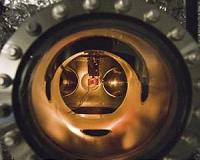 |
Tabernas, Spain (SPX) Aug 03, 2010 On average, sunlight illuminates every single square metre of the Earth with 1340 watts of power. Measured on human timescales, this energy source is infinite; it warms our planet, enables plants to grow and is the engine driving the winds and weather. But which technology is best able to harness the power of sunlight? Solar cells currently hold the record for converting the energy of sunlight into electrical power, with efficiency ratings greater than 40 percent. However, these photovoltaic cells are simply too expensive for use in large solar power stations. Standard commercial modules for large photovoltaic power stations are only gradually approaching the 20 percent threshold. With efficiency ratings of between 20 and 25 percent, solar thermal power stations are now sufficiently mature for dozens of these plants to be built or planned around the globe. Solar thermal power stations will also provide the backbone for power generation in the Sahara as part of the Desertec Industrial Initiative, where DLR researchers are currently hard at work on the scientific fundamentals. Solar energy can be stored as heat in these power stations, which means that they can generate electricity on demand and also after sunset.
More than 100 gigawatts of power from solar thermal power stations by 2020 Several scenarios for the future provision of power assume that within the next decade, solar thermal power stations with an aggregate power generation capacity of 100 to 200 gigawatts will be up and running. First in the plan is a focus on parabolic-trough power stations, in which curved mirrors direct sunlight to centrally-mounted absorber tubes. The concentrated rays of sunlight then heat oil circulating through these tubes to a temperature of up to 400 degrees Celsius. The oil then flows into a heat exchanger and transfers this heat to water. The steam generated in this process drives a generator via a turbine. As mature as this new technology is, we are still a long way from discovering its full potential. "At present, we are working on ways of moving away from oil, which is comparatively expensive," says Christoph Richter from the DLR Institute of Technical Thermodynamics (Institut fur Technische Thermodynamik) and facility manager at the DLR Solar Research site in Almeria, southern Spain. At the Plataforma Solar de Almeria, he and his colleagues are testing a process that enables the evaporation of water directly inside the absorber tubes and then to be circulated under high pressure. This makes it possible to achieve higher temperatures, up to 500 degrees. This is one way to further increase the efficiency of solar power stations and to produce cheaper solar power. After some promising results, Richter and his colleagues are currently planning to build a five-megawatt test plant.
Hydrogen from a solar tower Along with their work on parabolic troughs, DLR researchers are also driving forward the concept of solar tower power stations. This concept involves hundreds of mirrors, arranged in a semicircle, directing sunlight at a ceramic absorber block that is located centrally in the upper section of a tower. With temperatures in excess of 1000 degrees Celsius, and in a manner similar to the parabolic trough system, steam is produced and can be used to turn a generator turbine. "With these higher temperatures, tower power stations are able to achieve higher efficiencies," says Richter. Having said that, solar tower power stations are suited to more than simple power generation. "With this tremendous heat from concentrated sunlight, hydrogen can be obtained," explains Richter. For example, as part of the EU's HYDROSOL I and II projects, water molecules can be broken down into their constituent elements of hydrogen and oxygen at temperatures between 800 and 1200 degrees Celsius. This process is not yet suitable for commercial exploitation, but it does point the way towards a future in which solar thermal power stations not only generate electricity but also produce hydrogen, an energy source that is suitable for storage.
Share This Article With Planet Earth
Related Links DLR solar research at the Almeria site All About Solar Energy at SolarDaily.com
 U.S. researchers claim solar enegy advance
U.S. researchers claim solar enegy advancePalo Alto, Calif. (UPI) Aug 2, 2010 Scientists say a new process utilizing both the light and heat of solar radiation could double the efficiency of electricity-generating solar panels. Stanford University researchers say the technology, called "photon enhanced thermionic emission," could lower the costs of solar energy production to the point where it is competitive with oil as an energy source, a university release said ... read more |
|
| The content herein, unless otherwise known to be public domain, are Copyright 1995-2010 - SpaceDaily. AFP and UPI Wire Stories are copyright Agence France-Presse and United Press International. ESA Portal Reports are copyright European Space Agency. All NASA sourced material is public domain. Additional copyrights may apply in whole or part to other bona fide parties. Advertising does not imply endorsement,agreement or approval of any opinions, statements or information provided by SpaceDaily on any Web page published or hosted by SpaceDaily. Privacy Statement |